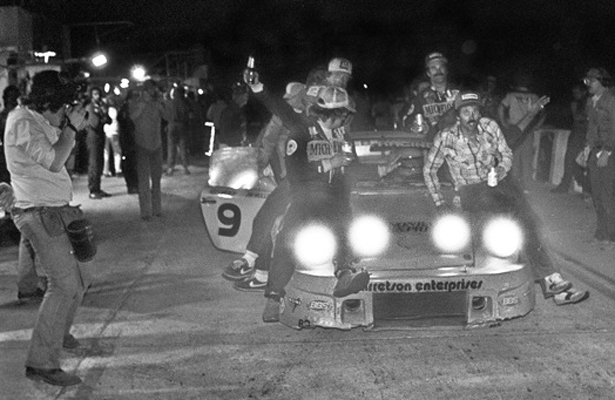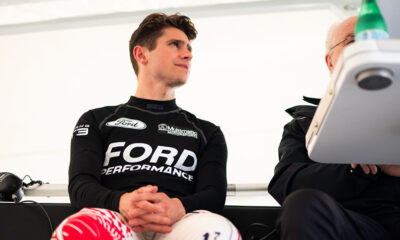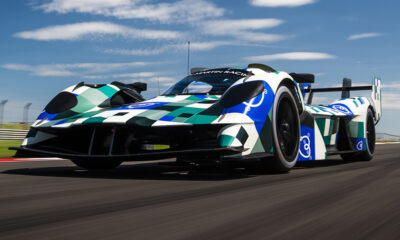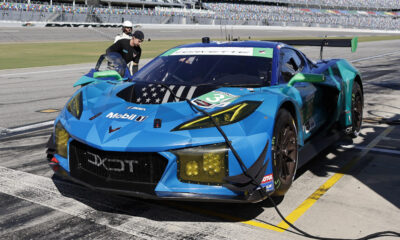
Photo: Sebring Archives
Sebring is known for the unexpected. Some of the most bizarre moments in endurance racing history have taken place at the historic circuit that originated from a WWII B-17 combat crew training base. We have chosen three races as perhaps the wildest ever: 1955, 1969 and in this final installment, the incredible 1983 race.
Sebring’s wildest race ever was also one of the best. The result was arguably the biggest upset in endurance racing history. The 1983 race featured a record number of leaders and lead changes, and the final few hours were thrilling… and bizarre.
A major change to the circuit was made prior to the 1983 race. The famous 5.2-mile circuit was reduced to 4.75-miles when a new segment was created to bypass a large portion of the active airport runways.
This was the first significant alteration to the Sebring circuit in its 30-year history. Although the Webster Turn was replaced with the Green Park Chicane in 1967, that was minor compared to this change.
This was a transitional year for IMSA and its Camel GT series. The new prototype formula was still in its infancy, but new GTPs were steadily joining the grid.
A few weeks before Sebring the first Grand Prix of Miami was held, attracting an impressive field of new prototypes from several different countries. Although a torrential rainstorm ended the race early, there was a new vibe in sports car racing.
Sebring had 84 cars on the starting grid in 1983, the largest in the history of the race. It was an odd mixture of top international teams, long-time IMSA competitors and club racers looking for an opportunity to compete in North America’s most historic endurance race.
Unfortunately, the large field would lead to a problem that went unnoticed until it was almost too late. Fuel, or the lack thereof, would become a serious problem.
Let the craziness begin.
The race week started with the pace car being stolen. The fan who “borrowed” it stated he was going to bring it back, but he needed to go to town for groceries.
Firewood was banned this year in effort to prevent the thick layer of smoke from descending on the circuit at night.
A scammer of sorts set up a stand selling wood not far from the circuit, betting most fans were unaware of the ban. Knowing the wood would be confiscated at the front gate, the seller had his partner bring it back to the roadside stand, where he resold the same pile of wood many times over.
Before “Highlands County justice” could be administered, the wood entrepreneur had disappeared.
The ban on firewood also led to another situation. Temperatures dropped unusually low during the race, especially after sunset. Fans began dismantling an old wooden building on the airport property for firewood, one of the many old structures around the facility. The problem was that it was actually someone’s house. The occupants were understandably unhappy.
After qualifying it became clear the Swap Shop Porsche 935 driven by Derek Bell, Michael Andretti and John Paul, Jr. would be the favorites.
They won the pole position, edging out the new Jaguar XJR-5 prototype of Bob Tullius and Bill Adam. Third fastest was the Chevrolet powered Phoenix built and entered by John Gunn with Ricardo Londono as co-driver. Qualifying fourth was the Chevrolet March 83G driven by Randy Lanier, Terry Wolters and Marty Hinze.
The top four qualifiers all had one thing in common: they wouldn’t be around by the halfway point of the race.
When the race started, it didn’t take long for asphalt at the new section of the circuit to starting breaking up, causing extended caution periods. And that little problem alluded to earlier caused by the record number of starters? There wasn’t enough fuel to finish the race.
The call went out and a fuel truck was dispatched. When the fuel truck arrived a few hours later, it couldn’t cross the track because the bridge into the paddock at that time could not accommodate a truck of that size. Officials had no choice but to call for a yellow flag and tightly bunch the huge field so it could safely make it across.
As the race progressed, it appeared two Porsche 935s were going to be the cars to beat. One was the Bayside entry driven by Hurley Haywood and Al Holbert, while the other had Bob Akin, John O’Steen and Dale Whittington at the wheel. But by the ninth hour, both of those cars were encountering mechanical issues. Moving up into contention was the Cosworth powered Grid of Skeeter McKitterick and Milt Minter.
At night, things even got crazier. A car getting lost at night on the runway sections of the circuit was nothing new. This had been happening for years. But with the new course configuration, many drivers were very confused.
One driver became so hopelessly lost he pulled next to a fence, got out of the car and climbed on the roof to get his bearings straight. He then saw several eyes watching him. He had driven on to ranch property neighboring the circuit and had attracted a welcome committee of cows.
This situation would be repeated many times during the early 1980s at Sebring, with even veteran drivers such as Giranpiero Moretti and Hurley Haywood experiencing “Sebring vertigo” and ending up among the bovines.
Another victim of the night hours at Sebring was a Porsche 935 that had become disabled on the side of the circuit (one of 42 cars that retired during the race).
While the driver walked back to the pits, fans in the area began picking the car apart for souvenirs. This story isn’t unique to Sebring, as it has happened at Le Mans as well. What was unique is that when the car arrived back in the paddock behind a tow truck, the team found a blowup doll sitting in the drivers seat. Of course, that raises another set of questions we won’t discuss here.
As the final hours approached and the top prototypes all encountered problems, the GTO class Mazda RX-7 of Pete Halsmer and Rick Knoop took the overall lead. This car had won class impressively at Daytona, and it looked like they were about to pull off an incredible upset, running a flawless race from 16th on the grid to take the lead.
The Mazda had a special 13B 2-rotor engine that had proven to be bullet proof. Mazda was on the verge of becoming the first Japanese manufacturer to win a major endurance race outright. But it was not to be. Brake problems resulted in an extended pit stop, and the problem was beyond repair.
When the Mazda retired, the Haywood/Holbert Porsche took the lead, but it was short-lived. Electrical problems and no headlights forced a pit stop. It seemed every car encountered a serious problem once they took the lead. Except one.
Qualifying 13th on the grid was the No. 9 Porsche 934 owned by Wayne Baker. Baker and his co-drivers Kees Nierop and Jim Mullen were probably the most underrated trio in the race. All three were experienced, talented drivers.
The crew had many talented people who had been on winning Sebring teams before. The yellow No. 9 took the lead in the final hour. Although the Cosworth Grid fell back with suspension problems, the Akin/Whittington/O’Steen car was in hot pursuit.
As Baker soldiered on in the final hour, he was assured that he was leading the GTO class, but the crew purposely didn’t tell him he was also leading overall!
With things seemingly under control, Baker suddenly radioed with instructions to tell IMSA race control someone was standing by the side the track hitchhiking between Turns 1 and 2. Yes, hitchhiking. Baker radioed again the next lap that the guy was still there, so security was dispatched (the law enforcement officer running to the scene stepped into a hole and broke his ankle).
Of course, a spectator on the circuit is no laughing matter. He was endangering himself and the drivers. But 34 years later it’s hard not to be amused, imagining a driver going through the very high-speed Turn 1 of the old circuit, then having his headlights illuminate a guy hitchhiking.
At about the same time the obviously intoxicated hitchhiker appeared (he later claimed he was looking for a lost dog), there were reports of an alligator along the side of the back straight. Alligators have occasionally made appearances at Sebring Raceway, but not during a race.
Wild boar are far more common. Just a year earlier actor James Brolin had hit one on the circuit. A wrecker crew cooked and ate the road kill that night.
It was now down to the final lap and Baker held a 90-second lead ahead of the Akin car. Crossing the finish line, Baker radioed to verify they the No. 9 won the GTO class, which was their goal all along. He was then informed “You just won OVERALL!”
Victory lane is always crazy at Sebring, but this year it was a true celebration. Wayne Baker’s team had pulled off the impossible, winning overall.
The No. 9 Porsche (chassis 0090030) had an incredible history, starting its competition life in 1979 with Dick Barbour Racing, taking a 2nd place finish at Le Mans. In 1981 the car, now owned by Bob Garretson, won the 24 Hours of Daytona.
There’s not enough space here to properly tell the story of this incredible car. Suffice to say by the time its competition life had ended in 1986, the Porsche had covered a total of 34,500 racing miles.
For the 1983 season, Baker had wisely assessed the IMSA rules and concluded the 934 configuration would be very competitive in the GTO class. The car had a single turbo 3.2-liter engine with a twin waste gate system. It was one of the few cars in the race that raced with Firestone tires.
While the Firestone tires proved to be problematic, the Firestone engineers devoted almost all their attention to the No. 9 car and they concluded a cantilever design tire used by Trans-Am cars would provide the best results. It worked.
The Bob Akin team managed to take second place followed by the Holbert/Haywood Porsche. Finishing fourth, and second in the GTO class, was the Chevrolet Monza driven by Luis Sereix, Brent O’Neill and Don Courtney. An Aston Martin Nimrod prototype finished fifth with Lyn St James, Reggie Smith and driving.
GTU honors went to the Mazda RX-7 of Jack Dunham, Jeff Kline and Jon Compton.
The following year at Sebring, history repeated itself with another incredible upset. An aging Porsche 935 that had actually been on display at a museum was driven to victory by Stefan Johansson, Hans Heyer and Mauricio De Narvaez. But nothing could ever top the crazy 1983 race.
EDITOR’S NOTE:
It would take a book to properly describe the 1983 race and the story of the car that won. That’s just what Ken Breslauer is doing. His book “War Horse and the Hitchhiker – The story of the 1983 Sebring 12 Hours” is due out next year.

























